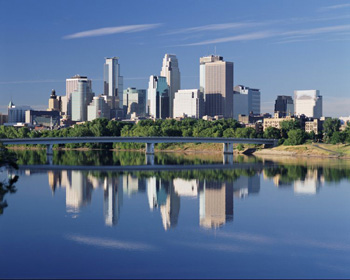 Saint
Paul
is
the capital and second-most populous city of the U.S. state of
Minnesota. The city lies mostly on the north bank of the Mississippi
River, downstream of the river's confluence with the Minnesota River,
and adjoins Minneapolis, the state's largest city. Known as the "Twin
Cities", these two cities form the core of Minneapolis-Saint Paul, the
16th-largest metropolitan area in the United States, with about 3.5
million residents. The city's population at the 2010 census was 285,068.
Saint Paul serves as the county seat of Ramsey County, the smallest and
most densely populated county in Minnesota.
Saint
Paul
is
the capital and second-most populous city of the U.S. state of
Minnesota. The city lies mostly on the north bank of the Mississippi
River, downstream of the river's confluence with the Minnesota River,
and adjoins Minneapolis, the state's largest city. Known as the "Twin
Cities", these two cities form the core of Minneapolis-Saint Paul, the
16th-largest metropolitan area in the United States, with about 3.5
million residents. The city's population at the 2010 census was 285,068.
Saint Paul serves as the county seat of Ramsey County, the smallest and
most densely populated county in Minnesota.
Founded near historic Native American settlements as a trading and transportation center, the city rose to prominence when it was named the capital of the Minnesota Territory in 1849. Though Minneapolis is more nationally recognized, Saint Paul contains important institutions and the state's political activity. Regionally, the city is popular for the Xcel Energy Center, home of the Minnesota Wild, and for the Science Museum of Minnesota. As a business hub of the Upper Midwest, it is headquarters for companies such as Ecolab and Lawson Software. Saint Paul, along with its Twin City, Minneapolis, is known for its high literacy rate. It is the only city in the United States with a population of 250,000 or more to increase the circulation number of Sunday newspapers in 2007.
The settlement originally began at present-day Lambert's Landing, but was referred to as Pig's Eye when Pierre "Pig's Eye" Parrant established a popular tavern there. When Fr. Lucien Galtier, the first Catholic pastor of the region, established the Log Chapel of Saint Paul (shortly thereafter to become the first location of the Cathedral of Saint Paul), he made it known that the settlement was now to be called by that name, as "Saint Paul as applied to a town or city was well appropriated, this monosyllable is short, sounds good, it is understood by all Christian denominations...".
The Mississippi River forms a municipal boundary on part of the city's west, southwest, and southeast sides. Minneapolis, the state's largest city, lies to the west. Falcon Heights, Lauderdale, Roseville, and Maplewood are north, with Maplewood lying to the east. The cities of West Saint Paul and South Saint Paul are to the south, as are Lilydale, Mendota, and Mendota Heights, although across the river from the city. The city's largest lakes are Pig's Eye Lake, which is part of the Mississippi, Lake Phalen, and Lake Como.The city has a total area of 56.2 square miles (145.5 km²). 52.8 square miles (136.7 km²) of it is land and 3.4 square miles (8.8 km²) of it (6.07%) is water.
Downtown had short skyscraper-building booms beginning in the 1970s. The tallest buildings, such as Galtier Plaza (Jackson and Sibley Towers), The Pointe of Saint Paul condominiums, and the city's tallest building, Wells Fargo Place (formerly Minnesota World Trade Center), were constructed in the late 1980s. In the 1990s and 2000s, the tradition of bringing new immigrant groups to the city continued. As of 2004, nearly 10% of the city's population were recent Hmong immigrants from Vietnam, Laos, Cambodia, Thailand, and Myanmar. Saint Paul is the location of the Hmong Archives.
The Minneapolis-Saint Paul-Bloomington area employs 1,570,700 people in the private sector as of July 2008, 82.43 percent of which work in private service providing-related jobs.
Major corporations headquartered in Saint Paul include Ecolab, a chemical and cleaning product company which was named in 2008 by the Minneapolis / St. Paul Business Journal as the eighth best place to work in the Twin Cites for companies with 1,000 full-time Minnesota employees, Securian Financial Group Inc., Lawson Software, a business software and support company, and Gander Mountain, a retailer of sporting goods which operates 115 stores in 23 states.
The 3M Company is often cited as one of Saint Paul's companies, though it is located in adjacent Maplewood, Minnesota. 3M employs 16,000 people throughout Minnesota. St. Jude Medical, a manufacturer of medical devices, is directly across the municipal border of Saint Paul in Little Canada, though the company's address is listed in Saint Paul.
The city is home to the Ford Motor Company's Twin Cities Assembly Plant, which opened in 1924. Recently slated for closing, Ford now expects the plant to remain open through at least 2011 despite massive corporate losses. The site is located in Highland Park on the Mississippi River adjacent to a company-owned dam which generates hydroelectric power.
Saint Paul is served by the Minneapolis-Saint Paul International Airport (MSP), which sits on 3,400 acres (14 km²) southwest of the city on the west side of the Mississippi River between Minnesota State Highway 5, Interstate 494, Minnesota State Highway 77, and Minnesota State Highway 62. The airport serves three international, twelve domestic, seven charter, and four regional carriers and is a hub and home base for Delta Air Lines, Mesaba Airlines and Sun Country Airlines. Saint Paul is also served by the St. Paul Downtown Airport located just south of downtown, across the Mississippi River. The airport, also known as Holman Field, is a reliever airport run by the Metropolitan Airports Commission. The airport houses Minnesota's Air National Guard and is tailored to local corporate aviation. There are three runways that serve about 100 resident aircraft and a flight training school. The Holman Field Administration Building and Riverside Hangar are on the National Register of Historic Places.